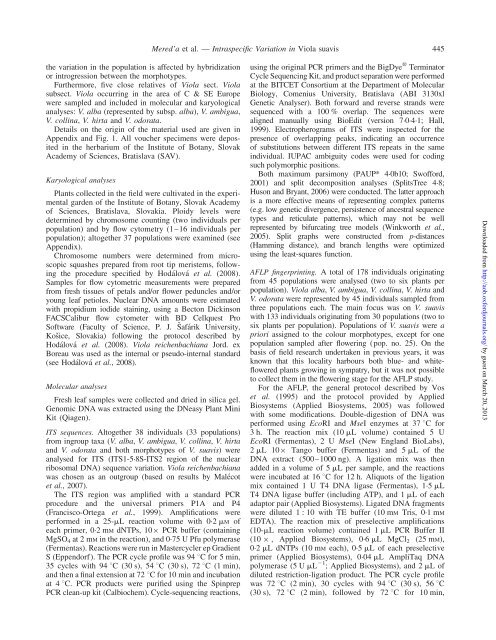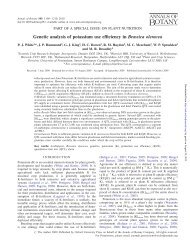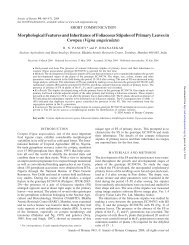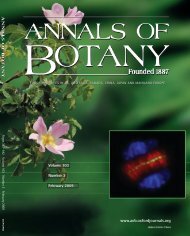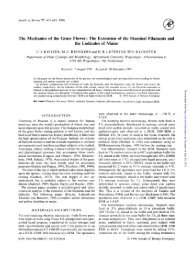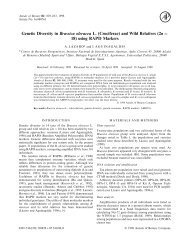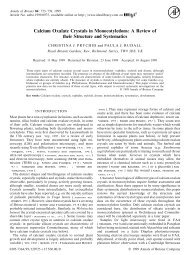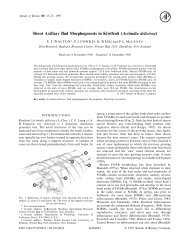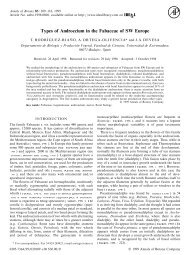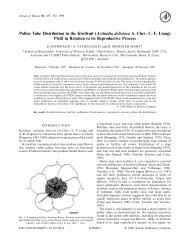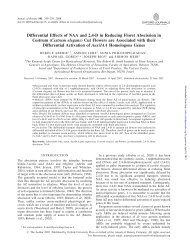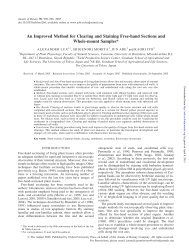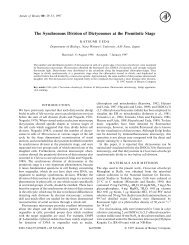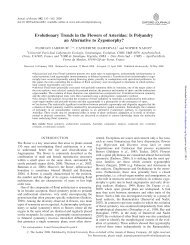Intraspecific Variation in Viola suavis in Europe ... - Annals of Botany
Intraspecific Variation in Viola suavis in Europe ... - Annals of Botany
Intraspecific Variation in Viola suavis in Europe ... - Annals of Botany
You also want an ePaper? Increase the reach of your titles
YUMPU automatically turns print PDFs into web optimized ePapers that Google loves.
the variation <strong>in</strong> the population is affected by hybridization<br />
or <strong>in</strong>trogression between the morphotypes.<br />
Furthermore, five close relatives <strong>of</strong> <strong>Viola</strong> sect. <strong>Viola</strong><br />
subsect. <strong>Viola</strong> occurr<strong>in</strong>g <strong>in</strong> the area <strong>of</strong> C & SE <strong>Europe</strong><br />
were sampled and <strong>in</strong>cluded <strong>in</strong> molecular and karyological<br />
analyses: V. alba (represented by subsp. alba), V. ambigua,<br />
V. coll<strong>in</strong>a, V. hirta and V. odorata.<br />
Details on the orig<strong>in</strong> <strong>of</strong> the material used are given <strong>in</strong><br />
Appendix and Fig. 1. All voucher specimens were deposited<br />
<strong>in</strong> the herbarium <strong>of</strong> the Institute <strong>of</strong> <strong>Botany</strong>, Slovak<br />
Academy <strong>of</strong> Sciences, Bratislava (SAV).<br />
Karyological analyses<br />
Plants collected <strong>in</strong> the field were cultivated <strong>in</strong> the experimental<br />
garden <strong>of</strong> the Institute <strong>of</strong> <strong>Botany</strong>, Slovak Academy<br />
<strong>of</strong> Sciences, Bratislava, Slovakia. Ploidy levels were<br />
determ<strong>in</strong>ed by chromosome count<strong>in</strong>g (two <strong>in</strong>dividuals per<br />
population) and by flow cytometry (1–16 <strong>in</strong>dividuals per<br />
population); altogether 37 populations were exam<strong>in</strong>ed (see<br />
Appendix).<br />
Chromosome numbers were determ<strong>in</strong>ed from microscopic<br />
squashes prepared from root tip meristems, follow<strong>in</strong>g<br />
the procedure specified by Hodálová et al. (2008).<br />
Samples for flow cytometric measurements were prepared<br />
from fresh tissues <strong>of</strong> petals and/or flower peduncles and/or<br />
young leaf petioles. Nuclear DNA amounts were estimated<br />
with propidium iodide sta<strong>in</strong><strong>in</strong>g, us<strong>in</strong>g a Becton Dick<strong>in</strong>son<br />
FACSCalibur flow cytometer with BD Cellquest Pro<br />
S<strong>of</strong>tware (Faculty <strong>of</strong> Science, P. J. Sˇ afárik University,<br />
Kosˇice, Slovakia) follow<strong>in</strong>g the protocol described by<br />
Hodálová et al. (2008). <strong>Viola</strong> reichenbachiana Jord. ex<br />
Boreau was used as the <strong>in</strong>ternal or pseudo-<strong>in</strong>ternal standard<br />
(see Hodálová et al., 2008).<br />
Molecular analyses<br />
Fresh leaf samples were collected and dried <strong>in</strong> silica gel.<br />
Genomic DNA was extracted us<strong>in</strong>g the DNeasy Plant M<strong>in</strong>i<br />
Kit (Qiagen).<br />
ITS sequences. Altogether 38 <strong>in</strong>dividuals (33 populations)<br />
from <strong>in</strong>group taxa (V. alba, V. ambigua, V. coll<strong>in</strong>a, V. hirta<br />
and V. odorata and both morphotypes <strong>of</strong> V. <strong>suavis</strong>) were<br />
analysed for ITS (ITS1-5.8S-ITS2 region <strong>of</strong> the nuclear<br />
ribosomal DNA) sequence variation. <strong>Viola</strong> reichenbachiana<br />
was chosen as an outgroup (based on results by Malécot<br />
et al., 2007).<br />
The ITS region was amplified with a standard PCR<br />
procedure and the universal primers P1A and P4<br />
(Francisco-Ortega et al., 1999). Amplifications were<br />
performed <strong>in</strong> a 25-mL reaction volume with 0.2 mM <strong>of</strong><br />
each primer, 0.2mM dNTPs, 10 PCR buffer (conta<strong>in</strong><strong>in</strong>g<br />
MgSO4 at 2 mM <strong>in</strong> the reaction), and 0.75 U Pfu polymerase<br />
(Fermentas). Reactions were run <strong>in</strong> Mastercycler ep Gradient<br />
S (Eppendorf). The PCR cycle pr<strong>of</strong>ile was 94 8C for 5 m<strong>in</strong>,<br />
35 cycles with 94 8C (30 s), 54 8C (30 s), 72 8C (1 m<strong>in</strong>),<br />
and then a f<strong>in</strong>al extension at 72 8C for 10 m<strong>in</strong> and <strong>in</strong>cubation<br />
at 4 8C. PCR products were purified us<strong>in</strong>g the Sp<strong>in</strong>prep<br />
PCR clean-up kit (Calbiochem). Cycle-sequenc<strong>in</strong>g reactions,<br />
Mered’a et al. — <strong>Intraspecific</strong> <strong>Variation</strong> <strong>in</strong> <strong>Viola</strong> <strong>suavis</strong> 445<br />
us<strong>in</strong>g the orig<strong>in</strong>al PCR primers and the BigDye w Term<strong>in</strong>ator<br />
Cycle Sequenc<strong>in</strong>g Kit, and product separation were performed<br />
at the BITCET Consortium at the Department <strong>of</strong> Molecular<br />
Biology, Comenius University, Bratislava (ABI 3130xl<br />
Genetic Analyser). Both forward and reverse strands were<br />
sequenced with a 100 % overlap. The sequences were<br />
aligned manually us<strong>in</strong>g BioEdit (version 7.0.4.1; Hall,<br />
1999). Electropherograms <strong>of</strong> ITS were <strong>in</strong>spected for the<br />
presence <strong>of</strong> overlapp<strong>in</strong>g peaks, <strong>in</strong>dicat<strong>in</strong>g an occurrence<br />
<strong>of</strong> substitutions between different ITS repeats <strong>in</strong> the same<br />
<strong>in</strong>dividual. IUPAC ambiguity codes were used for cod<strong>in</strong>g<br />
such polymorphic positions.<br />
Both maximum parsimony (PAUP* 4.0b10; Sw<strong>of</strong>ford,<br />
2001) and split decomposition analyses (SplitsTree 4.8;<br />
Huson and Bryant, 2006) were conducted. The latter approach<br />
is a more effective means <strong>of</strong> represent<strong>in</strong>g complex patterns<br />
(e.g. low genetic divergence, persistence <strong>of</strong> ancestral sequence<br />
types and reticulate patterns), which may not be well<br />
represented by bifurcat<strong>in</strong>g tree models (W<strong>in</strong>kworth et al.,<br />
2005). Split graphs were constructed from p-distances<br />
(Hamm<strong>in</strong>g distance), and branch lengths were optimized<br />
us<strong>in</strong>g the least-squares function.<br />
AFLP f<strong>in</strong>gerpr<strong>in</strong>t<strong>in</strong>g. A total <strong>of</strong> 178 <strong>in</strong>dividuals orig<strong>in</strong>at<strong>in</strong>g<br />
from 45 populations were analysed (two to six plants per<br />
population). <strong>Viola</strong> alba, V. ambigua, V. coll<strong>in</strong>a, V. hirta and<br />
V. odorata were represented by 45 <strong>in</strong>dividuals sampled from<br />
three populations each. The ma<strong>in</strong> focus was on V. <strong>suavis</strong><br />
with 133 <strong>in</strong>dividuals orig<strong>in</strong>at<strong>in</strong>g from 30 populations (two to<br />
six plants per population). Populations <strong>of</strong> V. <strong>suavis</strong> were a<br />
priori assigned to the colour morphotypes, except for one<br />
population sampled after flower<strong>in</strong>g (pop. no. 25). On the<br />
basis <strong>of</strong> field research undertaken <strong>in</strong> previous years, it was<br />
known that this locality harbours both blue- and whiteflowered<br />
plants grow<strong>in</strong>g <strong>in</strong> sympatry, but it was not possible<br />
to collect them <strong>in</strong> the flower<strong>in</strong>g stage for the AFLP study.<br />
For the AFLP, the general protocol described by Vos<br />
et al. (1995) and the protocol provided by Applied<br />
Biosystems (Applied Biosystems, 2005) was followed<br />
with some modifications. Double-digestion <strong>of</strong> DNA was<br />
performed us<strong>in</strong>g EcoRI and MseI enzymes at 37 8C for<br />
3 h. The reaction mix (10 mL volume) conta<strong>in</strong>ed 5 U<br />
EcoRI (Fermentas), 2 U MseI (New England BioLabs),<br />
2 mL 10 Tango buffer (Fermentas) and 5 mL <strong>of</strong> the<br />
DNA extract (500–1000 ng). A ligation mix was then<br />
added <strong>in</strong> a volume <strong>of</strong> 5 mL per sample, and the reactions<br />
were <strong>in</strong>cubated at 16 8C for 12 h. Aliquots <strong>of</strong> the ligation<br />
mix conta<strong>in</strong>ed 1 U T4 DNA ligase (Fermentas), 1.5 mL<br />
T4 DNA ligase buffer (<strong>in</strong>clud<strong>in</strong>g ATP), and 1 mL <strong>of</strong>each<br />
adaptor pair (Applied Biosystems). Ligated DNA fragments<br />
were diluted 1 : 10 with TE buffer (10 mM Tris, 0.1 mM<br />
EDTA). The reaction mix <strong>of</strong> preselective amplifications<br />
(10-mL reaction volume) conta<strong>in</strong>ed 1 mL PCR Buffer II<br />
(10 , Applied Biosystems), 0.6 mL MgCl2 (25 mM),<br />
0.2 mL dNTPs (10 mM each), 0.5 mL <strong>of</strong> each preselective<br />
primer (Applied Biosystems), 0.04 mL AmpliTaq DNA<br />
polymerase (5 U mL 21 ; Applied Biosystems), and 2 mL <strong>of</strong><br />
diluted restriction-ligation product. The PCR cycle pr<strong>of</strong>ile<br />
was 72 8C (2 m<strong>in</strong>), 30 cycles with 94 8C (30 s), 56 8C<br />
(30 s), 72 8C (2 m<strong>in</strong>), followed by 72 8C for 10 m<strong>in</strong>,<br />
Downloaded from<br />
http://aob.oxfordjournals.org/ by guest on March 20, 2013


